
"Sinbad", or sometimes spelled in English as "Sindbad" was a sailor mentioned in Middle Eastern stories associated with a collection of folk tales known as the "One Thousand and One Nights". However, his tale, like the two other most popular "Aladdin and His Magic Lamp" and "Ali Baba and the Forty Thieves" were not part of the original grouping. They did not appear as part of the stories until 1701 when in France Antoine Galland published his translation.
According to the folklore "Captain Sinbad" was a sailor during the early part of the "Abbasid Caliphate". Which was the third Islamic Caliphate to follow that of the "Prophet Muhammad". The adventurer lived in Baghdad during the 8th to 9th Centuries and in his Seven Voyages fought monsters in magical realms that of course made for great movie material.
The first time "Sinbad" appeared on the motion picture screen was in a 1920 cartoon with artwork by Swiss and German artist Paul Klee. It would be interesting to have found a still from this lost cartoon, because Klee was known for working in Expressionism, Cubism and Surrealism. Which would not seem to be the style of drawing for an animated tale about an Arabian sailor.

Below is a 1922 painting by Paul Klee.
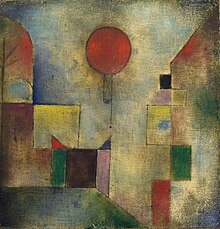
More to the norm was the next Sinbad the Sailor Cartoon by American animator Ub Iwerks in 1935 from his own studio.

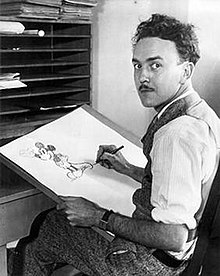
Iwerks previously had worked with another artist name Walt Disney to create both "Oswald the Lucky Rabbit" and "Mickey Mouse", before leaving over artistic differences.
Between that first 1920 cartoon and a 2016 animated series on "Netflix"/ The character of "Sinbad the Sailor" appeared in 42 different titles. This article is not going to look at all of those titles, but concentrate on the 41 year period between 1936 and 1977. When I believe some of the best and most original work appeared.
Max Fleischer was an innovator not a visionary. Most animated cartoons ran 7 minutes, or less. Max came up with the innovative idea of making a longer two reel cartoon. He took one of his two popular creations "Popeye the Sailor", the other was "Betty Boop", and created "Popeye the Sailor Meets Sinbad the Sailor". Which was released November 27, 1936. Portraying "Sinbad" was "Bluto" and the damsel in distress was of course "Olive Oyl".Instead of a 7 minute one reel cartoon this "Popeye" entry ran just over 16 minutes/
"Sinbad's" island was inhabited by animals and various types of monsters.

"Popeye the Sailor Meets Sinbad the Sailor" was nominated for an Oscar for Best Short Subject. It lost to Walt Disney's "Silly Symphony" entry "Country Cousin" about a mouse from the country coming to visit his city cousin and the problems that arise. It had been released one month before on October 31, 1936. This was just another notch in the feud between Max and Walt.
There would be two more "Arabian Nights" tales for "Popeye", "Olive" and "Bluto". They were the 17 minute "Popeye the Sailor Meets Ali Baba's Forty Thieves", November 26, 1937, and "Aladdin and His Wonderful Lamp". At 22 minutes in length released on April 7, 1939.
I said Max was an innovator and not a visionary. One month after Fleischer released his second "Popeye" feature opening on December 21 1937 at the Carthay Circle Theatre in Los Angeles.Walt Disney released his first animated feature film at a running time of 83 minutes. "Snow White and the Seven Dwarfs" changed the world of animation forever.
Max Fleischer and Walt Disney would have a feud lasting until 1954. When Walt did an amazing thing to end it and again prove he was the visionary. You can read about these two animators in my article at:
http://www.bewaretheblog.com/2015/04/the-great-walt-disney-max-fleischer.html
Returning to "Sinbad the Sailor".
On the movie screen in the U.K. and the United States he was simply "Sabu". He had been born on January 27, 1924 in Karapur, Mysore, Kingdom of Mysore in British India. In 1940 at the age of 16 he starred in the Korda Brothers production of "The Thief of Bagdad". Misspelled without the "H" as other film makers would also do. In April of 1942 Sabu starred as "Mowgli" in the Korda Brothers live action production of Rudyard Kipling's "The Jungle Book".
Now he was the star of a Universal Studios Production entitled Arabian Nights" released Christmas Day 1942.
Alexander, Zolton and Vincent Korda brought to the screen many masterpieces of film making between 1919 and 1956. Including the only feature film written for the screen by H.G. Wells. Their story can be read at:
http://www.bewaretheblog.com/2016/04/alexander-zoltan-vincent-korda-brothers.html
_02.jpg)
"Arabian Nights" starts out in a harem with an elderly overseer telling the story in flashback. Making it seem like one of the original folk tales out of "One Thousand and One Nights". This is the tale of the young caliph "Haroun-Al-Raschid" played by Jon Hall and his wife "Sherazade" played by Maria Montez. The use of the name "Sherazade" gives the impression the picture is one of the original stories and not just a name in the plot from Michael Hogan and True Boadman. The motion picture was the first of six pairings of Montez and Hall in similar stories.
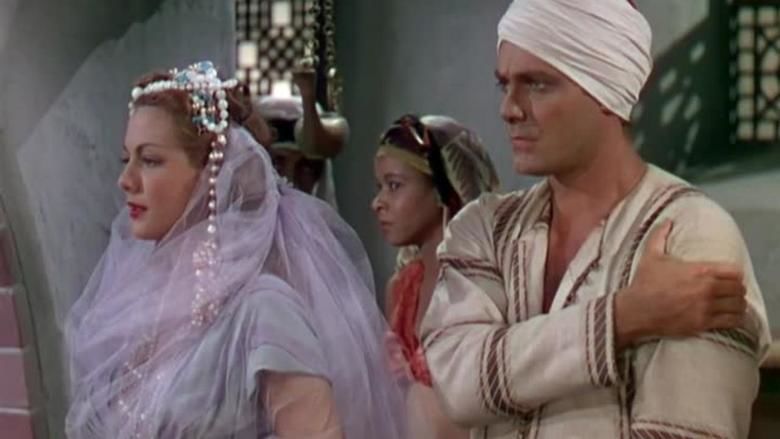
Now enters "Sinbad" for comic relief. In the story "Sherazade" is a dancer in a traveling troop owned by "Ahmad" comedian Billy Gilbert. In the troop are "Sinbad the Sailor" and "Aladdin",
"Sinbad" was portrayed by comedian Shemp Howard. Shemp was one of the original "Three Stooges" until he decided to take on other acting roles/ Then his brother "Curly" took over with their other brother Moe and cousin Larry Fine. "Aladdin" was played by character actor John Qualen.
Below left to right: Gilbert, Howard and Qualen.

The villain of the piece is Leif Erickson as "Kamar: the brother of "Haroun-Al-Raschid". Who of course wants the throne.I could not locate a still of the actor in this picture.
Fantasy adventure motion pictures such as "Arabian Nights" were very popular during World War 2. Along with Pirate movies that carried the audiences away from their concerns of rationing and the war. This trend continued even after the war ended into the first half of the 1950's. As even major movie studios searched for ways to avoid the condemnation of the "House Committee on UnAmerican Activities" during the McCarthy Era.
In 1947 "Sinbad the Sailor" a movie from Howard Hughes's, RKO Pictures, premiered. I would first see it on our black and white television set, but it was filmed in glorious Technicolor.
Portraying "Sinbad" was Douglas Fairbanks, Jr. taking after his father in such films as the original 1924 "Thief of Bagdad" and 1926's "The Black Pirate", or his own 1937 "The Prisoner of Zenda" and 1939's "Gunga Din". Fairbanks, Jr. was still considered on active duty with the with the United States Navy and had to wear his uniform when he was not filming. The actor was embarrassed as he was a highly decorated Naval Officer with rows of ribbons some from France and England for his service.
Portraying the harem girl of his dreams, "Shireen", was Maureen O'Hara. O'Hara was "Esmerala" in the classic 1939 "The Hunchback of Notre Dame", or had appeared in two pirate features by this time. They were 1942's "The Black Swan" opposite Tyrone Power and "The Spanish Main" in 1945 opposite Paul Henreid. It would be three years later, before she teamed up with John Wayne for the first time in 1950's "Rio Grande".
As with most "Arabian Nights" movies. This is a tale told in flashback by "Sinbad" himself to an assembled audience around a fire by the boat dock. The movie is about his "Eighth" voyage and opens with:
O Masters, O Noble Persons, O Brothers, know you that in the time of the Caliph Harun-Al-Rashid, there lived on the golden shore of Persia a man of adventure called Sinbad the Sailor. Strange and wondrous were the tales told of him and his voyages. But who, shall we surmise, gave him his immortality? Who, more than all other sons of Allah, spread glory to the name of Sinbad? Who else, O Brother, but - Sinbad the Sailor! Know me, O Brothers, for the truth of my words, and by the ears of the Prophet, every word I have spoken is truth.The story is about a quest for the lost treasure of Alexander the Great on the mythical island of "Daryabar".
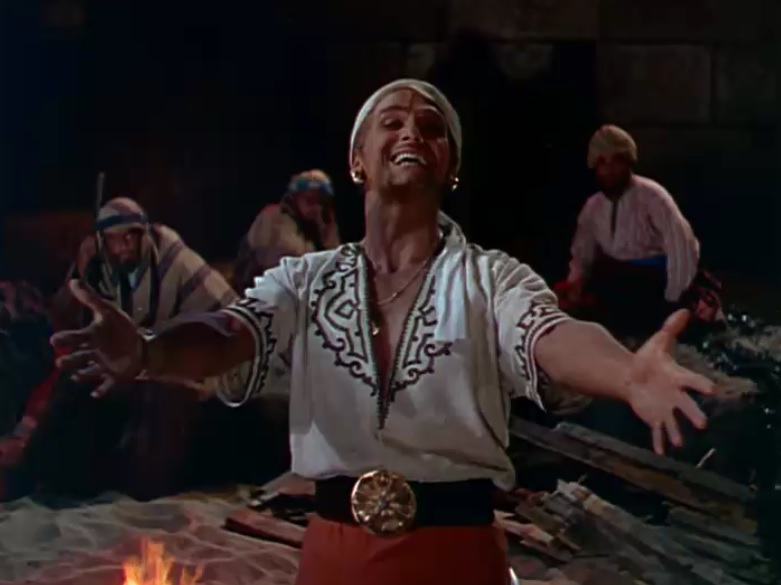
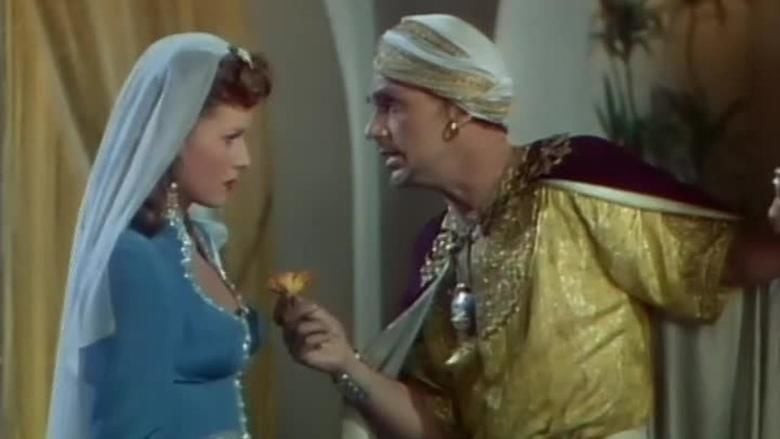
Around "Sinbad's" neck is a medallion he has worn since birth, or so he says. It shows the way to the fabled Treasure Island, or so it is thought. The fun, and this film still is, starts when Fairbanks, Jr. first sees O'Hara and decides to sneak into the harem of the evil "Emir of Daibul" played by Anthony Quinn.
Although Quinn had appeared in Cecil B. DeMille's 1938 "The Buccaneer", DeMille's 1939 "Union Pacific", Bob Hope and Paulette Goddard's 1940 "Ghost Breakers", Raul Walsh's 1941 "They Died With Their Boots On", the aforementioned 1942 "Black Swan", William Wellman's classic "The Ox-Bow Incident" in 1943 and had second billing behind John Wayne in 1945's "Back to Bataan". He was still not considered a star by Hollywood as shown with this fourth billed role.
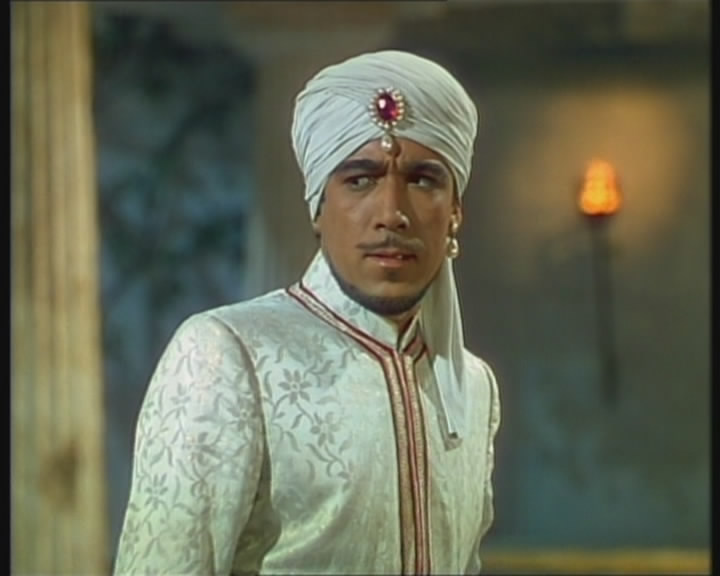
Then there is Walter Slezak as the barber "Melik", or is he the assassin known as "Jamal"? Third billed Slezak will always be remembered for his understated role of the U-Boat Captain in Alfred Hitchcock's 1944 'Lifeboat". Playing Nazi's was a typical role for the actor. His comedic talents were used in 1949's "The Inspector General" starring Danny Kaye, or stealing the picture from Rock Hudson and Gina Lollobrigida in 1961's "Come September" co-starring the married couple of Sandy Dee and Bobby Darin. His comic touch adds to the terror of "Jamal". Walter Slezak also had fun deliberately playing over the top pirates such as in the Bob Hope and Virginia Mayo 1944 "The Princess and the Pirate", or the aforementioned "The Spanish Main".

All four become involved with the search for Daryabar and the answer to the question is "Sinbad" really a "Prince" and heir to the wealth of the fabled island? As I mentioned John Twist's screenplay is full of fun and adventure. Among Twist's work would be "King Richard and the Crusaders" in 1954 and Robert Wise's epic "Helen of Troy" in 1956.

Above Quinn is ready to kill Fairbanks, Jr until he notices the medallion and the search for Alexander the Great's Island begins. Part of the crew will be the barber played by Slezak. Attempted murder will occur on the voyage and the discovery of "Jamal".

When they arrive at the island it is deserted and everything is in ruins. There is an old man referred to by the real title of "Alga" portrayed by Alan Napier. Napier would become "Alfred", "Bruce Wayne's" butler on the television's "Batman" starring Adam West and Bruce Ward.
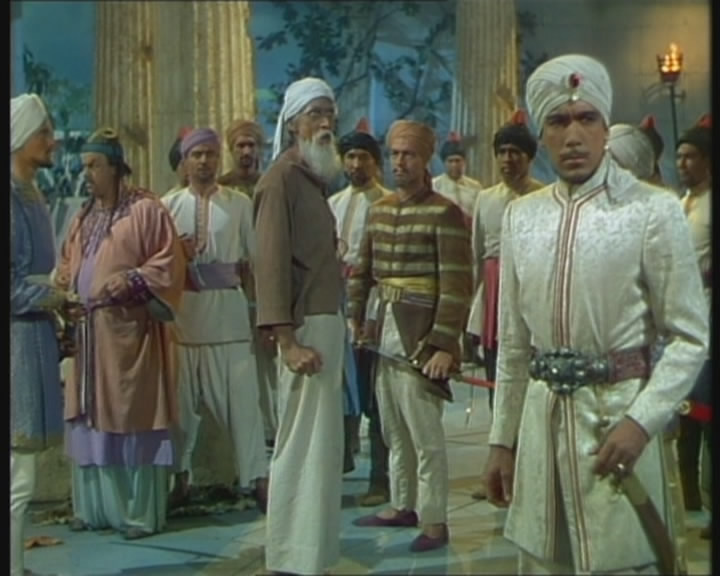

It is obvious that "Sinbad" is "Aga's" real son.but to protect the old man. He reveals himself not to be the lost "Prince of Daryabar, but the
Greatest Liar in the entire Islamic World Sinbad the Sailor.Which causes "Shireen" to admit her love to him.
The "Aga" relates the story of how he came to the island and the treasure that has caused many men's deaths. However, he also speaks of the real treasure of love which "Sinbad" and "Shireen" appear to have.
"Sinbad" tells the "Emir" that "Jamal" planned to kill him with poison as he did to others before. This leads to the "Emir" forcing "Jamal" to drink his own poison. The "Aga" reveals the treasure of Alexander the Great and while sitting in it "Jamal" finally dies from the poison.

The "Emir" orders his men to bag up the treasure and take it to his ship. He also has "Shireen", against her will, taken there. What he does not know is that one of the bags contains "Sinbad". Who now proceeds to free his imprisoned crew and the other men chained to the oars. As the "Emir" is returning in a long boat. "Sinbad" has Greek Fire sent by a catapult at him. In the end the "Emir" is hit by the balls of fire. "Sinbad' ends his story at this point, but those he is talking too do not believe the tale. "Sinbad" first produces some of Alexander's treasure and then finally "Shireen".
The next motion picture about "Sinbad" was actually about the "Son of Sinbad". The movie was also a Howard Hughes production and was shot in 3-D for release in 1953. However, like previously when Howard Hughes had problems with the Motion Picture Production Code over Jane Russell's bra size in "The Outlaw". Delaying that pictures actual release from 1943 until 1946. He now had a somewhat similar problem with "Son of Sinbad". Delaying this film by two years to a new release date of June 1, 1955 and as a result the picture was not in 3-D, but converted, at additional costs, to a widescreen process.
Oh, that similar problem? It was the clothing worn, or not, by the harem girls. Especially the one in the front of the following still Lili St. Cyr as "Nerissa". The film was being considered amoral and not for family viewing.

America must protect the morality of our youth. Oh, did I fail to mention that besides Gypsy Rose Lee and Ann Corio. Lili St. Cyr was the most recognizable "Strip Tease Artist" in the United States.
Richard O'Brien's lyrics for the song "Fanfare/don't dream it" from "The Rocky Horror Picture Show" says it all:
God Bless Lili St Cyr
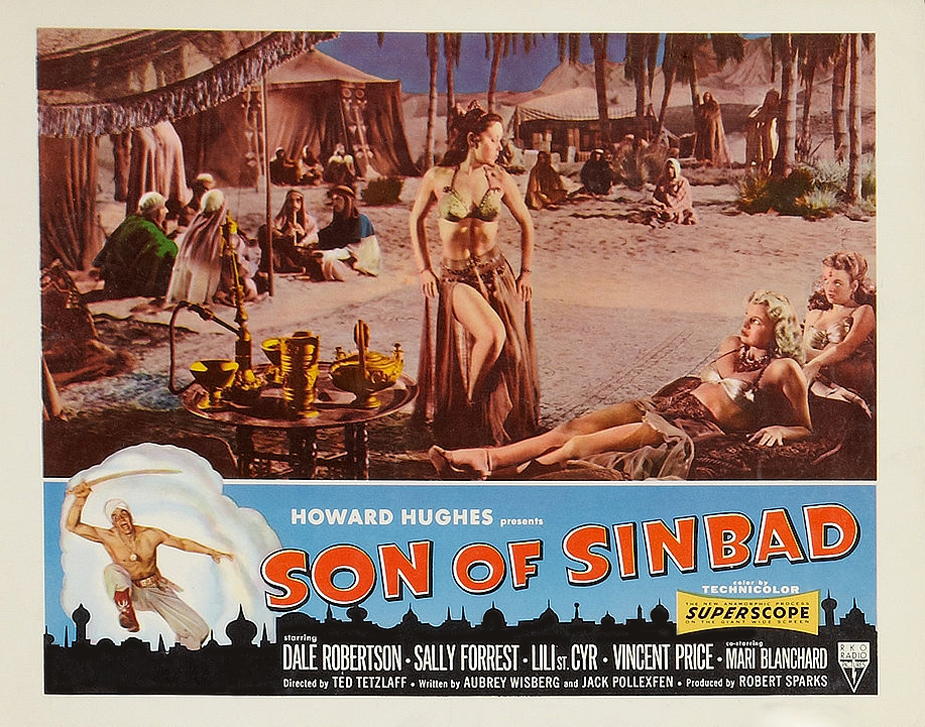
Playing "Sinbad's" son also named "Sinbad" was Dale Robertson. Two years after "Son of Sinbad" was released Robertson would play agent "Jim Hardie" in the first of 201 episodes of "Tales of Wells Fargo" on television.

Above in the middle is Dale Robertson. To his right in what was suppose to be his fourth 3-D motion picture was Vincent Price. Price was having a lot of fun hamming it up as Persian Poet "Omar Khayyam". To Dale's left is second billed Sally Forrest as "Ameer".
Sally Forrest is an interesting personality. She starred in three films by actress, writer and director Ida Lupino portraying strong women in stories that were basically taboo at the time. 1949's "Unwanted" portraying an unwed mother. The same year's "Never Fear" as a dancer with a promising career struck down by polio and 1951's "Hard, Fast and Beautiful" based upon a novel itself based upon the life of tennis champion Helen Willis. The first American Women Tennis champion to become a global celebrity.
Forest co-starred in Fritz Lang's 1956 film "While the City Sleeps". She was also a dancer and without on screen credit assisted with the choreography of the Frank Sinatra and Kathryn Grayson movie "The Kissing Bandit" in 1949. Did the same work for the 1951 motion picture "Valentino" and was a chorus dancer in the MGM Musicals "Till the Clouds Roll By", 1946, "The Unfinished Dance" and "Fiesta" both in 1947 and the Judy Garland films "The Pirate" and "Easter Parade" in 1948.
Sally Forrest and her husband writer, the head of CBS television casting, Milos Frank purchased the home owned by Jean Harlow and Paul Bern on Benedict Canyon in Beverly Hills. They sold it to hairstylist Jay Sebring and just after moving in. Sebring was murdered along with Sharon Tate by Charles Manson's followers in Tate's home.
For Christmas 1958 and released on December 22nd was a motion picture that not only was about "Sinbad the Sailor", but has an impact on Fantasy Films still today. "The 7th Voyage of Sinbad" was a double first for stop motion animator Ray Harryhausen. This was his first motion picture made in Technicolor and his first in the process "Dynamation".

"The 7th Voyage of Sinbad" was Ray's third production with his partner producer Charles H. Schneer for their "Morningside Productions". Schneer and Harryhausen became a team with "It, Came from Beneath the Sea" and would remain such through "Clash of the Titans". Most fans of Ray Harryhausen over look Charles H. Schneer, but his very interesting career may be found in my biography at:
http://www.bewaretheblog.com/2016/09/charles-h-schneer-look-at-work-of.html
The motion picture was directed by Nathan Juran. Among his work was "20 Million Miles to Earth", "The Deadly Mantis" and the original "Attack of the 50 Foot Women". My article on the director may be found at:
http://www.bewaretheblog.com/2017/05/nathan-h-juran-look-at-work-of-man-who.html
The motion picture starred Kerwin Mathews as "Sinbad". Matthews would be back for Harryhausen and Schneer in "The 3 Worlds of Gulliver" aka: "The Three Worlds of Guilver" in 1960. He would also be seen in producer Edward Small's original 1962 "Jack the Giant Killer". That picture was directed by Nathan Juran and had stop motion partly by a young Jim Danforth. Among his other varied work saw Kerrwin Matthews in Hammer Films 1962 "The Pirates of Blood River" starring Christopher Lee and he would also be in Nathan Juran's 1973 "The Boy Who Cried Werewolf" as the Werewolf.

My article on Nathan Juran the director of "The Deadly Mantis", the original "Attack of the 50 Foot Women" and "The Brain from Planet Arous" among other works. May be read at:
http://www.bewaretheblog.com/2017/05/nathan-h-juran-look-at-work-of-man-who.html
Kathryn Grant portrayed the lovely "Princess Parisa" who is shrunk to doll size by the evil magician. Grant had been acting since 1953 and would stop after voicing another princess in an 1959 animated feature. She had been seen in the Science Fiction movie "The Night the World Exploded" a low budget 1957 film. Her last two 1959 features were Otto Preminger's "Anatomy of a Murder" starring James Stewart and Irwin Allen's "The Big Circus" starring Victor Mature.
The reason her career just stopped was because of a visitor to the set, in Spain, during live action filming named Bing Crosby. They fell in love and were married before the year was out and this picture released.

Third billing went to child actor Richard Eyer as "Barani, the genie".Eyer had been acting since 1952 with an appearance on television's "The Roy Rodgers Show". He drove Humphrey Bogart's convict nuts as Fredrick March's son in William Wyler's "The Desperate Hours" in 1955. The year before this picture was released. Richard Eyer was the boy who puts "Robby the Robot" back together as "The Invisible Boy".
I wrote an article comparing the lives of Richard Eyer to another child star of the 1950's and 1960's Charles Herbert, the original "The Fly", Bert I. Gordon's "The Boy and the Pirate" and William Castle's original "13 Ghosts". You can read how fame and family put them on different paths and outcomes at:
http://www.bewaretheblog.com/2016/06/richard-eyer-and-charles-herbert-child.html

"Sokurah" the scene stealing evil magician was portrayed by British character actor Torin Thatcher. He would portray the evil sorcerer "Pendragon" in "Jack the Giant Killer". Which was a direct rip off of this role.
Torin Thatcher had some really great supporting roles. In 1952 he was "Humble Bellows" in the Burt Lancaster movie "The Crimson Pirate". A must for all fans of "Captain Jack Sparrow" as Lancaster's "Captain Vallow" is considered the Grandfather of Johnny Depps character. He was "Sir Henry Morgan" in the same years "Blackbeard the Pirate" starring Robert Newton and appeared with Newton and Richard Burton in the World War 2 drama "The Desert Rats" released in 1953 Thatcher helped Tony Curtis cut his wife Janet Lee in half in George Pal's "Houdini". The actor also appeared on the original "Star Trek" television series.

My biography of Torin Thatcher may be read at:
http://www.bewaretheblog.com/2017/07/torin-thatcher-career-of-great-british.html
The story opens with "Sinbad" and his crew requiring new supplies and landing on the Island of Colossa. On board is his betrothed the "Princess Parisa". Their marriage will unite Chandra and Baghdad. Leaving the Princess and her servant "Sadi", Nana DeHerrera, on board. "Sinbad" and some of his crew go ashore in a long boat.
Suddenly, "Sokurah" comes running with his magic lamp being chased by a Cyclops.
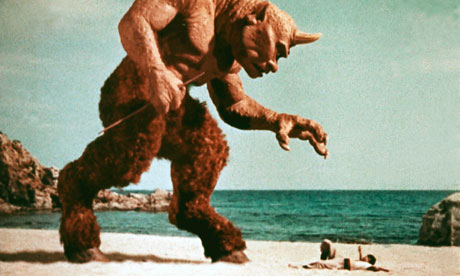
Some of "Sinbad's" crew are killed and the magician uses the lamp to call the genie. The genie protects the escaping group with an invisible wall, but the Cyclops tosses a large boulder over it causing the long boat to capsize. The lamp is lost and picked up by the Cyclops/ While "Sokurah" is saved by "Sinbad" from drowning. On board "Sinbad's" ship the magician offers precious jewels, for help getting his lamp back. "Sinbad" refuses as he must get "Parisa" to Baghdad.
Back in Baghdad the "Caliph", Alec Mango, entertains his guest "Parisa's" father the "Sultan of Chandra", Harold Kasket. "Sokurah" entertains by turning "Princess Parisa's" handmaid "Sadi" into a half women half snake dancer.

"Sokurah" is asked to look into the future of both Chandra and Baghdad. At first he refuses, but "lets" himself be convinced to do it. In an attempt to get a ship to return to Colossa. He foretells of War between the two Kingdoms. The "Caliph" banishes "Sokurah" and says that if he is not gone by the following nightfall his eyes will be cut out. As "Parisa" is sleeping the magician casts a spell that shrinks her to doll size. Everything that has happened is all part of the magician's plan, because of course one of the ingredients needed to restore her size. Is part of an eggshell of the giant two headed bird called a Roc found only on Colossa.
A crew of mostly convicts is put together and "Sinbad" with the shrunken "Parisa" set sail with "Sokurah". Who thinks only of getting the lamp back. When the ship arrives a giant cross bow designed by the magician is assembled. Some of the crew left to man it and "Sokurah", purposely, divides the rest of the crew between "Sinbad" and himself as they set out to find the Roc.
"Sinbad's" group finds the treasure cave of the Cyclops and the lamp, but the creature attacks and places them in a cage.
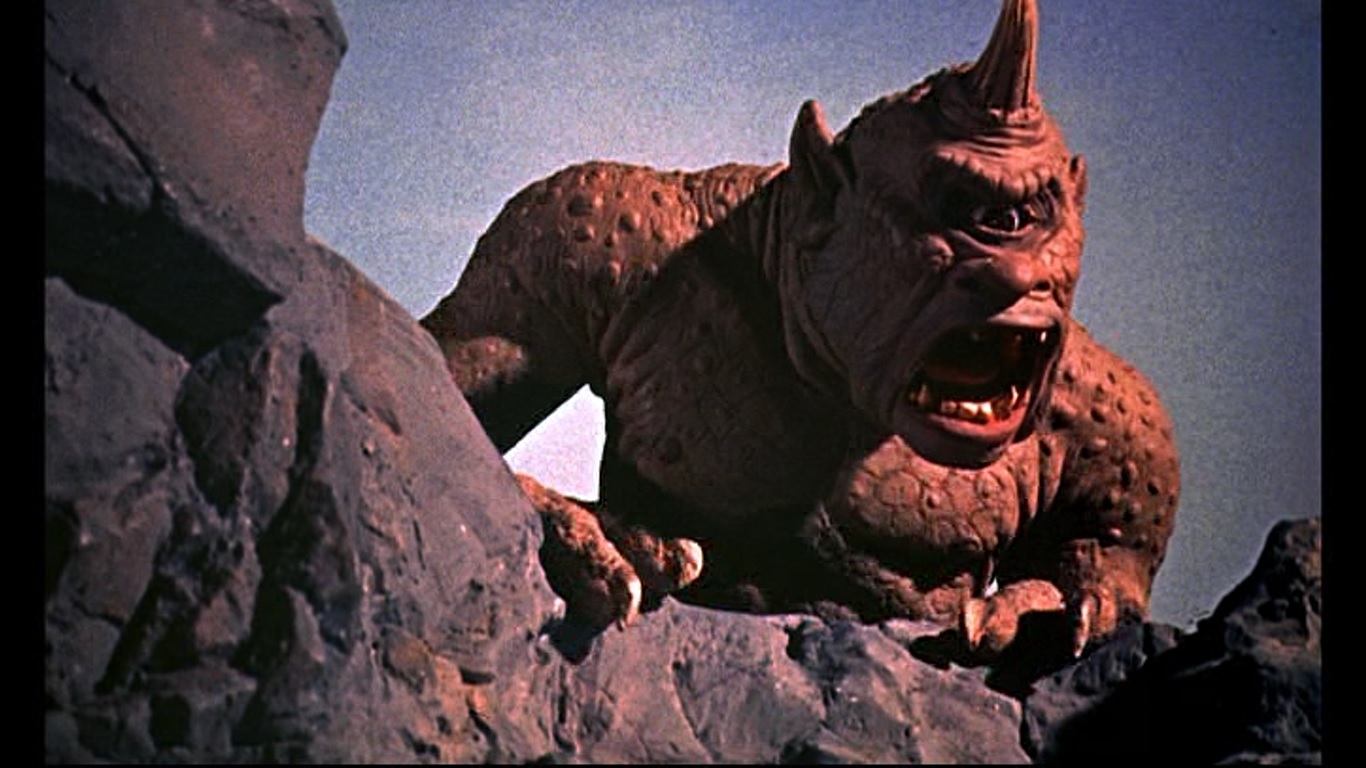

While in the cage "Sokurah" comes by, but does not offer to help., Instead with the Cyclops distracted he enters the cave and retrieves the magic lamp.
"Sinbad" reveals "Parsia" and with her help the men are able to escape. "Sokurah" finds himself being chased by the Cyclops and once again is saved by "Sinbad". Who blinds the one eyed giant and leads it off a cliff. In the chase the lamp had been dropped by the magician and "Sinbad" decides to keep it until "Sokurah" restores "Parsia" to her normal size.
The magician leads "Sinbad" and his men to a Roc's nest with an egg in it. The hungry men crack open the giant egg to reveal a two headed Roc chick. They then kill and cook it.

While this is occurring "Sinbad" asks "Parsia" to enter the lamp and find out how to call the genie.

This is were screenplay writer Kenneth Kolb's dialogue really comes into play. First the "Princess" discovers the genie's real name is "Barani", and then the words of the promise of becoming a real boy.
When the big that is small shall again become tall, into fiery rock to rise you must fall.Part of this promise is obvious to "Parisa". As it seems to mean after she returns to normal size. The other part is still unclear. Then there is perhaps one of the most known lines in any Fantasy motion picture. How to call the genie of the lamp:
From the land beyond beyond... from the world past hope and fear... I bid you Genie, now appear.As "Sinbad" repeats those words the mother Roc attacks.

She kills the remaining crew members, grabs "Sinbad" in her talons and fly's away with the magic lamp. "Sokurah" captures the "Princess" and takes her to his underground castle to await "Sinbad".
Waking up in the nest. "Sinbad" takes a piece of eggshell and summons the genie. Who tells him how to avoid the dragon guarding the entrance.

"Sinbad" gives the eggshell to "Sokurah" to restore "Princess Parsia" to her normal size.

After this is done the magician requests the magic lamp. "Sinbad" tells him the lamp will be his once they are safely on the beach. "Sokurah" instead animates a skeleton to fight "Sinbad" in what is a classic stop motion animation sequence.


"Sinbad" defeats the skeleton and leaves with "Princes Parsia" and the magic lamp. "Sokurah" starts to follow. "Parsia" seeing the lava flow below them, as they cross a stone bridge, remembers the passage in the genie's promise of freedom:
into fiery rock to rise you must fall.and convinces "Sinbad" to toss the lamp into the lava make "Sokurha" becomes overcome with rage. After the two leave the cave and head for the beach. The magician frees the dragon and under his control leads him to the beach.

Another Cyclops appears and a battle between it and the dragon commences. In the end the Cyclops is killed and the dragon turns upon "Sinbad" and his crew. Manning the giant Cross Bow they fire the arrow and the dragon collapses dead upon "Sokurah".
At sea "Princess Parsia" tells "Sinbad" she wishes "Barani" was there. At which point the now real boy appears along with his wedding gift . The treasure of the Cyclops.
On June 16, 1962 a Japanese anime motion picture entitled アラビアンナイト シンドバットの冒険 Arabian Naito: Shindobatto no Bōken (Arabian Nights: Sinbad's Adventure) premiered. It was never released in a dub version in the United States, but did get released in Mexico and Romania. This was from Toei Studios. "Sinbad" stows away on a ship to find a fabulous treasure on a map he has discovered.

On October 1, 1975 another Japanese anime with the same title as the 1962 film premised on Fuji Television made by Nippon Animation. The 52 episodes were aimed at a young audience. In this anime "Sinbad" is a young boy who with his pet bird sail the seas in search of adventure.
 |
|In 1962 American International Pictures released the motion picture "The Magic Voyages of Sinbad". In reality this was a 1953 Soviet Union Fantasy motion picture called "Sadko" renamed and dubbed into English by Roger Corman's "Filmgroup" subsidiary.


"Sadko" renamed "Sinbad" is a braggart in this picture based upon a Russian Legend. His bragging catches up with him as he is forced to go on a quest for the "Sweet Voiced Bird of Happiness".
Between donning the mask in Walt Disney's "Zorro" and getting "Lost in Space". Guy Williams was "Captain Sinbad" in a movie from the King Brothers filmed in Germany. The feature was released June 19, 1963.
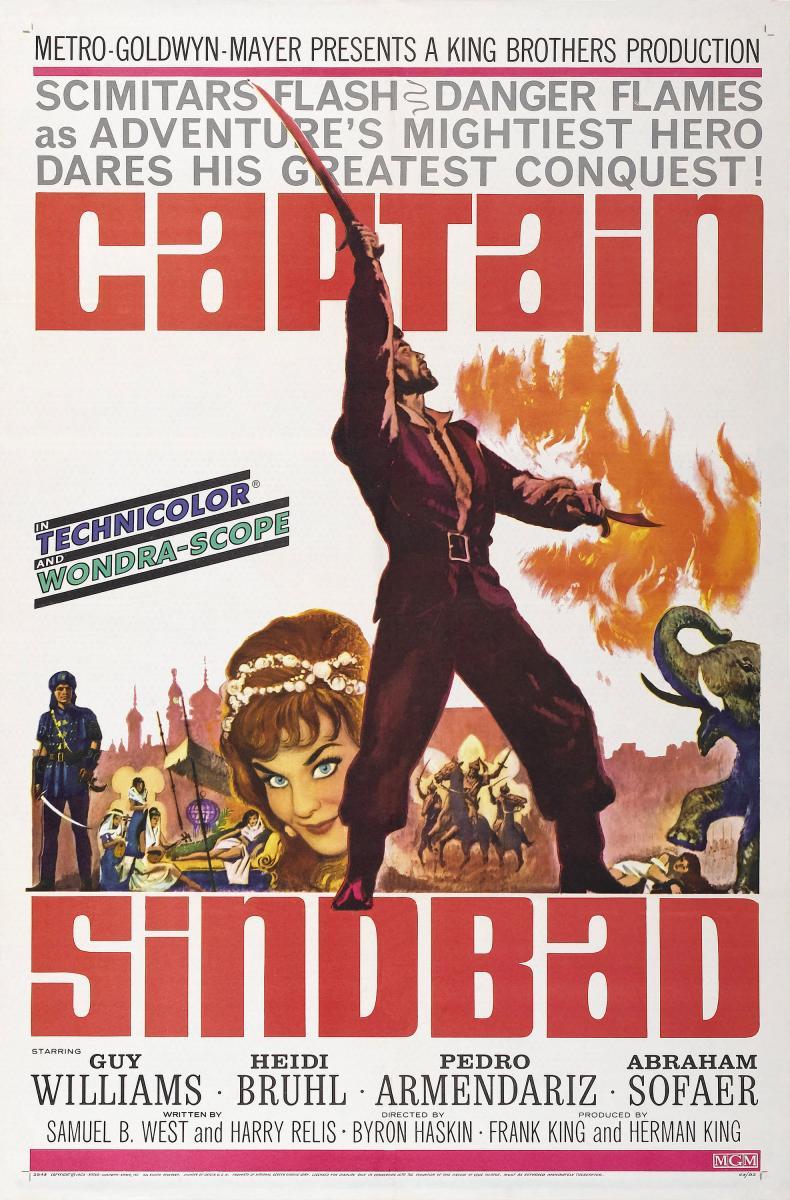
For fans of Guy Williams I would give you a bit of trivia. The next time you watch Michael Landon in 1957's "I Was A Teenage Werewolf". Look for the actor portraying "Police Officer Chris Stanley", or go back to his first motion picture, in 1947, about the Manhattan Project "The Beginning, or the End". Not to be confused with Bert I. Gordon's film from ten years later. 1957's "The Beginning of the End" about giant grasshoppers eating Chicago. In "The Beginning, or the End" my reader will see Guy Williams as the bombardier for the Enola Gay dropping the Atomic Bomb on Hiroshima.
Portraying the "Princess Jana" was German singer and actress Heidi Bruhl. In 1975 American audiences saw the actress co-starring with Clint Eastwood in the thriller "The Eiger Sanction" and she appeared in an episode of Robert Young's television series "Marcus Welby, M.D." in 1976. Otherwise she was mainly in German and European productions.
Portraying the villain of "Captain Sinbad", "El Kerim", was the great Mexican actor and member of the "John Ford Stock Company" Pedro Armendariz. Appearing in 1948 in both "The Three Godfathers" and "Fort Apache" with John Wayne. He was also the co-star in Howard Hughes' 1956 production about Genghis Khan "The Conqueror". His co-stars were Wayne and Susan Hayward both of whom died from cancer. The film was shot on a Utah Atomic Test Site and what happened to the cast, crew and visitors is worth looking up. In the same year as this film Armendariz portrayed "Kerim Bey" in the second James Bond big screen feature "From Russia With Love". "Captain Sinbad" was released the day after Pedro Armindariz committed suicide as a result of his cancer going back to the late 1950's.
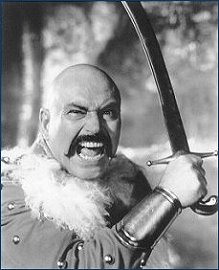
Portraying the scatter brained wizard "Gaigo" was veteran character actor Abraham Sofaer.

The motion picture was directed by Byron Haskin. Among Haskin's work as a director you will find Walt Disney's "Treasure Island", three from producer George Pal the "War of the Worlds", "The Naked Jungle" and "Conquest of Space". So the picture was in outstanding hands, if only the budget had been there.
"Captain Sinbad" can be best described as a mix Ray Harryhausen's "The 7th Voyage of Sinbad" with lifts from the Korda's 1940 "Thief of Bagdad", but with a juvenile screenplay aimed at a preteen audience. Still you have an enjoyable low budget Fantasy of the period. Such as 1960's "The Wizard of Baghdad" starring comedian Dick Shawn, 1961's "The Thief of Baghdad" made in Italy starring Steve Reeves, or 1962's "The Golden Arrow", also made in Italy, with 1950's American Teen Idol Tab Hunter.
"Sinbad" is returning from a voyage to marry the "Princess Jana". The land of Baristan is ruled by the evil "El Kerim". Who also is in love with the "Princes" and wants to capture "Sinbad" upon his return and have him executed. "Jana" learns of this and goes to "Gaigo" for help. He turns her into a "Fire Bird" to be able to fly out to "Sinbad's" ship and warn him, but "El Kerim" finds out about her plan.

He forces the wizard to turn two of his guards into giant falcons. They fly out to the ship and sink it, before "Princess Jana" can warn her true love.

When the "Princess" returns "El Kerim" captures her in bird form as she changes back into a women in his hand."Sinbad" is rescued and returns to Baristan disguised as petty thief, but is captured.
Brought before "El Kerim", "Sinbad" is condemned to be executed, but escapes those holding him. Grabbing a sword he is able to stab "El Kerim" directly in the heart. Only to discover that the evil ruler can not die and has a secret.

"Sinbad" is to be put to death in the Public Arena as a sign of "El Kerim's" power. The heroic "Captain Sinbad" is to fight an Invisible Opponent in the arena known by the original name of "The Thing". During the fight "The Thing" knocks over a torch causing a fire and panic. This enables "Sinbad" to escape and find "Gaigo". Who now reveals that "El Kerim's" heart is kept in a tower guarded by magical forces and creatures. "Sinbad" is able to round up his remaining men and they start for the tower. Meanwhile "El Kerim" informs "Princess Jana" that once his men capture "Sinbad". They will both be put to death.

After fighting Carnivorous Vines, Giant Prehistoric Crocodiles, Lava Pits and Whirlpools. "Captain Sinbad's" crew has been reduced in size as they finally arrive at the tower. By this time the very bad special effects seem like they could not be topped, but now "Sinbad" must confront what is described as an "Ogre with the Multiple Heads of a Dragon" at the foot of the tower.

With his background I wonder what Bryon Haskin actually thought of German Karl Baumgartner's Special Effects Department at the time? Here is that "Ogre with the Multiple Heads of a Dragon".



To add to the confusion some reviewers decided that Guy Williams was not fighting an "Ogre with the Multiple Heads of a Dragon" even if the Press Book said so, but a "Hydra".
As I am ripping apart the Special Effects in "Captain Sinbad". On the exact same day as that feature's release June 19, 1963. The competition immediately became Ray Harryhausen's "Jason and the Argonauts". Which also opened and talk about a "Hydra".

To be fair this was only Karl Baumgartner's fourth motion picture and perhaps he was also thinking "Hydra". Over the years he would work on two classic war films. These were 1981's "Das Boot" and the overlooked and outstanding 1993 "Stalingrad". While along the way there were Clint Eastwood's 1970 motion picture "Kelly's Heroes" and the excellent Science Fiction "Enemy Mine" starring Dennis Quaid and Louis Gossett, Jr.
Returning to "Captain Sinbad" after the whatever it is gets killed. "Sinbad" must climb a giant rope to get to "El Kerim's" heart.
.

Once in the tower room, yes, "Captain Sinbad" must fight a Giant Glove seen below.

"El Kerim's" heart is within a crystal and during the glove fight "Sinbad" is able to break the crystal exposing the heart. Instantly the evil ruler has a heart attack. He gets the wizard "Gaigo" to use the flying chariot to reach the tower room to fight "Sinbad".
A sword fight between the two begins and as this is occurring. "Gaigo" gets the exposed heart and tosses it over the tower balcony.

As his heart falls "El Kerim" faints and also falls over the balcony to his death. The people of Baristan rejoice at the wedding of "Captain Sinbad" and "Princess Jana".
Toho Studios released on October 26,1963 in Japan "Daitozoku (Either The Great Bandits, or The Great Thief depending on the translation)". The motion picture wouldn't reach the United States, when I first saw it, from American International Pictures until March 3, 1965 as "The Lost World of Sinbad".
+Original_1.jpg)
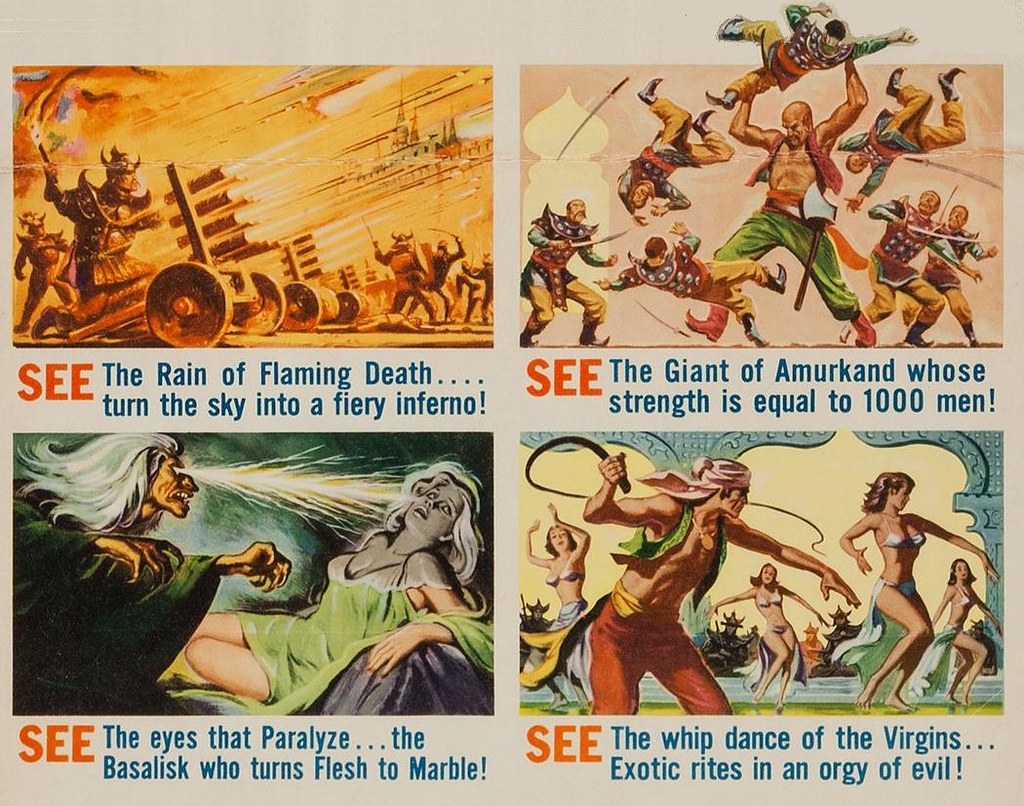
Portraying in the original Japanese version "Sukezaemon Naya" was the great Japanese actor Toshiro Mifune. The star of Akira Kurosawa's "The Seven Samurai", "Throne of Blood", "Rashomon" and "Yojimbo" among other motion pictures both period and modern such as "Storm Over the Pacific".

Portraying the beautiful "Princess Yaya" was Mie Hama. Fans of Toho's Kaiju know her from both "King Kong vs Godzilla" and "King Kong Escapes" as the evil "Madame Piranha". Mie was also "Bond Girl" "Kissy Suzuki" in "You Only Live Twice"

Portraying "Miwa" the Rebel Leader is another Toho Kaiju favorite Kumi Mizuno. Probably best known to fans of "Godzilla" as "Miss Namikawa" in "Invasion of the Astro-Monster". Her other roles included "Gorath", "Frankenstein Conquerors the World", "War of the Gargantuas" and "Godzilla, Final Wars".
The basic story has Toshiro Mifune fighting an evil witch with the help of a sex starved old wizard to rescue the "Princess". While falling in love with the Rebel Leader. Even in the English dubbed dialogue changed version by American International Pictures. Where there is no sex starved wizard in a family movie, but just an old fool. "The Lost World of Sinbad" is a fun motion picture as only Toho can create.
How about mixing your Arabian Nights? On December 18, 1964 the Italian motion picture "Sindbad contro i sette saraceni (Sindbad Against the Seven Saracens)" premiered. When the movie was dubbed into English by American International Pictures it suddenly became "Ali Baba and the Seven Saracens".The plot was typical "Peplum" aka: "Sword and Sandal" Italian movie of the period. As the Rebel Leader returns to fight the Evil Tyrant and free the city.
In 1965 India released "Sindbad, Ali Baba, Aladin". This Hindi motion picture was in actuality a major dance production from "Bollywood" starring the popular Burma born Indian actress "Helen" (Helen Richardson Khan).

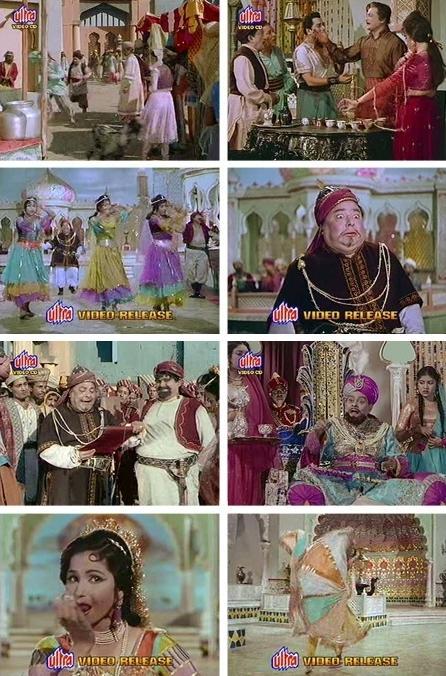
Between 1965 and 1966 Hanna-Barbera produced and released 102 five minute cartoons. The rights to the story had been acquired from a defunct 1960 animation company. It is possible there were actual cartoons produced by that other company, but are presumed lost. However, the name "Sinbad Jr. and his Magic Belt" had to be changed to "Sinbad Jr. the Sailor". before this American made cartoon series could be shown on American television.
The name change was negotiated to avoid copyright infringement with American International Pictures, because they owned the rights to the dubbed version of "Sadko" and the trademark name "Sinbad". Apparently the main problem was not the name "Sinbad", but the use of the word "Magic" in the original title.
The plots of each cartoon had no relationship to the Arabian Nights, but the main character is the son of the famous sea explorer also named "Sinbad".

In 1971 Turkey produced "Shehzade Sinbad kaf daginda (Either: Prince Sinbad of Kaf Montain, or Sinbad of the Montains)". The picture starred popular Turkish leading man Fikret Hakan as "Sindad" and as the "Prenses Saliha" Swedish born Turkish actress Eva Bender.

According to a Turkish website:
http://sinematikyesilcam.com/2012/05/sehzade-sinbad-kaf-daginda-1971/
Part of the review in a translated description, in broken English, reads:
---is a film that is very inferior compared to foreign productions. Sailor Sinbad does not see the sea except to go to suck the venom of the serpent that puts on the prospective partner's bosom, or does not say that it is related to the sea. In the other Sinbad movies, the monsters who are confronted are replaced by Erol Taş, who is as bad as a monster .Erol Tas was a Turkish actor portraying the role of "Kasim". From the above description it would seem that there are no monsters to fight, but as in 1947's "Sinbad the Sailor". Just an evil villain.
On June 23, 1973 "Simbad e il califfo di Bagdad (Sinbad and the Caliph of Bagdad)" premiered in Italy. The movie was produced and directed by Pietro Francisci. For those unfamiliar with Francisci's work. He directed both Steve Reeves vehicles "Hercules" and "Hercules Unchained". Pietro also did the screenplays for those two pictures and this production.

Below Sonia Wilson and Robert Malcolm.


It took a while and a few translations to find a plot summary.
https://www.comingsoon.it/film/simbad-e-il-califfo-di-bagdad/10913/scheda/
Tired of being a sailor, Simbad returns to his country where he discovers that his house and all his possessions have been confiscated. Victim of two cheaters, Firùz and Bamàn, he finds himself with them, against his will, on a ship that brings the beautiful Sherazade as wife to the cruel Caliph of Baghdad. Found in the company of the young girl, she is abandoned at sea, with Firùz and Bamàn, on a boat destined to shipwreck on a small island. Among the wrecks of a Chinese ship, Simbad discovers a balloon with which he rises and reaches Baghdad. Extraordinarily resembling the Caliph, he is convinced by some officials who want to overthrow him to take his place. The plot succeeds, but Simbad, who has found the love of Sherazade, renounces power and leaves with her for other shores.In the United Kingdom on December 20, 1973 the new master of stop motion animation Ray Harryhausen and his producer partner Charles H. Schneer were back with "The Golden Voyage of Sinbad" starring the under appreciated John Philip Law.
+2+by+Brian+Bysouth.jpg)
John Phillip Law had in many ways out done Clint Eastwood "Man With No Name" against Lee Van Cleef in the 1967 Spaghetti Western "Death Rides a Horse" as "Bill Meceita". Law was more prominently seen, outside of Europe, in Roger Vadim's "Barbarella" starring Vadim's wife, at the time, Jane Fonda. John Philip Law the blind angel "Pygar" who gets both women at the end. "Barbarella" was released in 1968 and is considered a Cult Science Fiction Classic.
The actor chosen to portray the evil wizard "Prince Koura". Had already portrayed "Rasputin" in producer Sam Spiegel's epic screen version of Robert K, Massie's bestselling biography "Nicholas and Alexandria" in 1971. In 1973 he portrayed the "Sea Captain" in the British television production "Frankenstein the True Story" starring James Mason, Jane Seymour and David McCallum among others. Tom Baker's portrayal of "Prince Koura" would change the minds of the producers of "Dr. Who". They would not go with their first choice of Christopher Lee. Baker became the "Fourth Doctor". Still the fans favorite from what is now called "The Classic Dr. Who".

The role of "Margiana" went to actress Caroline Munro. According to Munro it was screenplay writer Brian Clemens that helped convince Charles H. Schneer to give her the role.. Besides this screenplay Clemens wrote the original pilot for the BBC's 1961 program "The Avengers" and remained script supervisor. His Hammer films included two original takes 1971's "Dr. Jekyll and Sister Hyde" and 1974's "Captain Kronos: Vampire Hunter".
In an interview for the extras on the British DVD release of this picture. Caroline Murnro stated:
I got the part – I had been signed by Hammer, for one year, for a contract, out of which I did two films, one being Dracula AD 1972, and the second one being Captain Kronos - Vampire Hunter, which, kind of, would come full-circle, to Sinbad. It was written and directed by Brian Clemens, who wrote the screenplay for The Golden Voyage of Sinbad, so, I was lucky enough to be chosen for Captain Kronos, and they were searching for somebody to do Sinbad, and they wanted a big name, somebody American, or well-known, but Brian said "No". He kept lobbying Charles Schneer [producer] and ray Harryhausen — saying: 'I think you should come and look at the rushes, and see what you think, because I think she's right'. So, they said "No", but, eventually, Brian persuaded them to do that, and they saw the rushes, and that was how I got the part
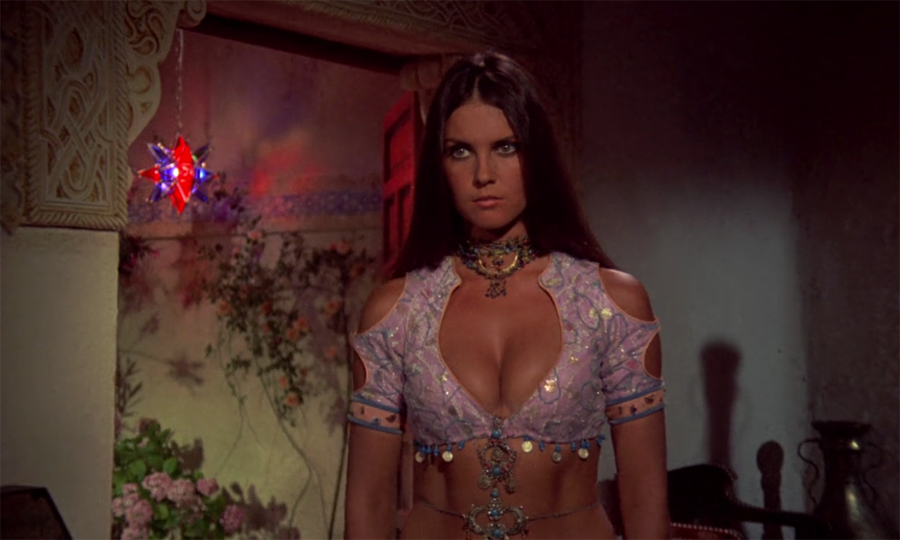
The story starts with "Sinbad" enjoying a calm sea and the end of another adventure. A strange bird like creature drops a golden tablet onto the deck of the ship and the sailor uses it as a amulet around his neck. Suddenly, a terrible storm just starts for no apparent reason throwing his ship off course. That night "Sinbad' dreams of a man in black calling his name and a beautiful girl with an eye tattooed on her hand,
The storm subsides and "Sinbad's" ship is off the coastal town of Marabia. The sailor decides to swim to shore ahead of his ship reaching port and as he comes out of the water. He immediately meets the man in black from his dream. Who is of course "Prince Koura" demanding the amulet back. "Sinbad" escapes into the city only to meet the "Grand Vizier", Douglas Wilmer, in his golden mask, see picture above, covering his disfigured face.
Douglas Wilmer appeared in many historical motion pictures and Shakespearean plays. He was seen among his 99 feature films in 1961's "El Cid" starring Charlton Heston and Sophia Loren, the 1963 Elizabeth Taylor/Richard Burton "Cleopatra", he was "Pelias" in Ray Harryhausen's 1963's "Jason and the Argonauts" and portrayed "Detective Nayland Smith", opposite Christopher Lee, in 1966's "The Brides of Fu Manchu" and 1967's "The Vengeance of Fu Manchu".
The "Grand Vizier" meets "Sinbad" and asks for his help to find "The Fountain of Destiny". Which will grant youth, a shield of darkness and riches. The fountain is located on the lost continent of Lemuria. The amulet "Prince Koura" is part of three pieces when joined together will lead them to Lemuria. The voyage is set and :Koura: will follow and attempt to stop it through dark magic.
Before "Sinbad" sails he sees the girl of his dreams "Margiana". She is a slave, but the slave owner wants "Sinbad'" to take his son to sea and make a man of him. "Sinbad" promises to do this, IF "Margiana" comes along also. He feels somehow she is connected to this quest.

Along the way the pursuing "Prince Koura" uses his own blood to create creatures and his life force is slowly beong drained as he appears older and older.
"Koura" brings the figurehead of "Sinbad's" ship to life to steal the amulet and other items. A statue of the Indian Goddess "Kali" also comes to life under Ray Harryhausen's magic later in the movie.
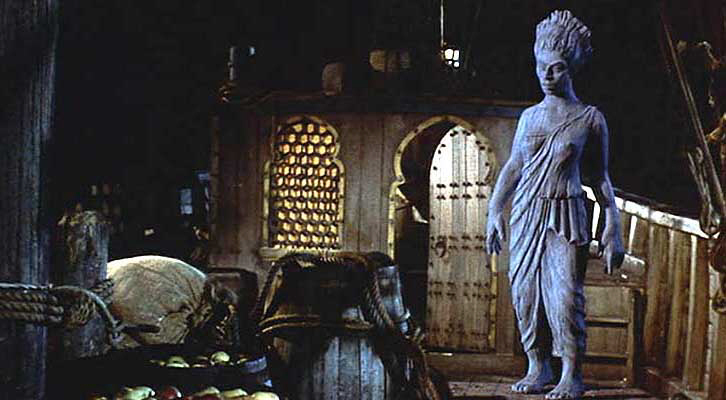


In the end "Sinbad" and "Prince Koura" will fight at "The Fountain of Destiny", but before that final confrontation more of Harryhausen's magic brings the story to a climax.

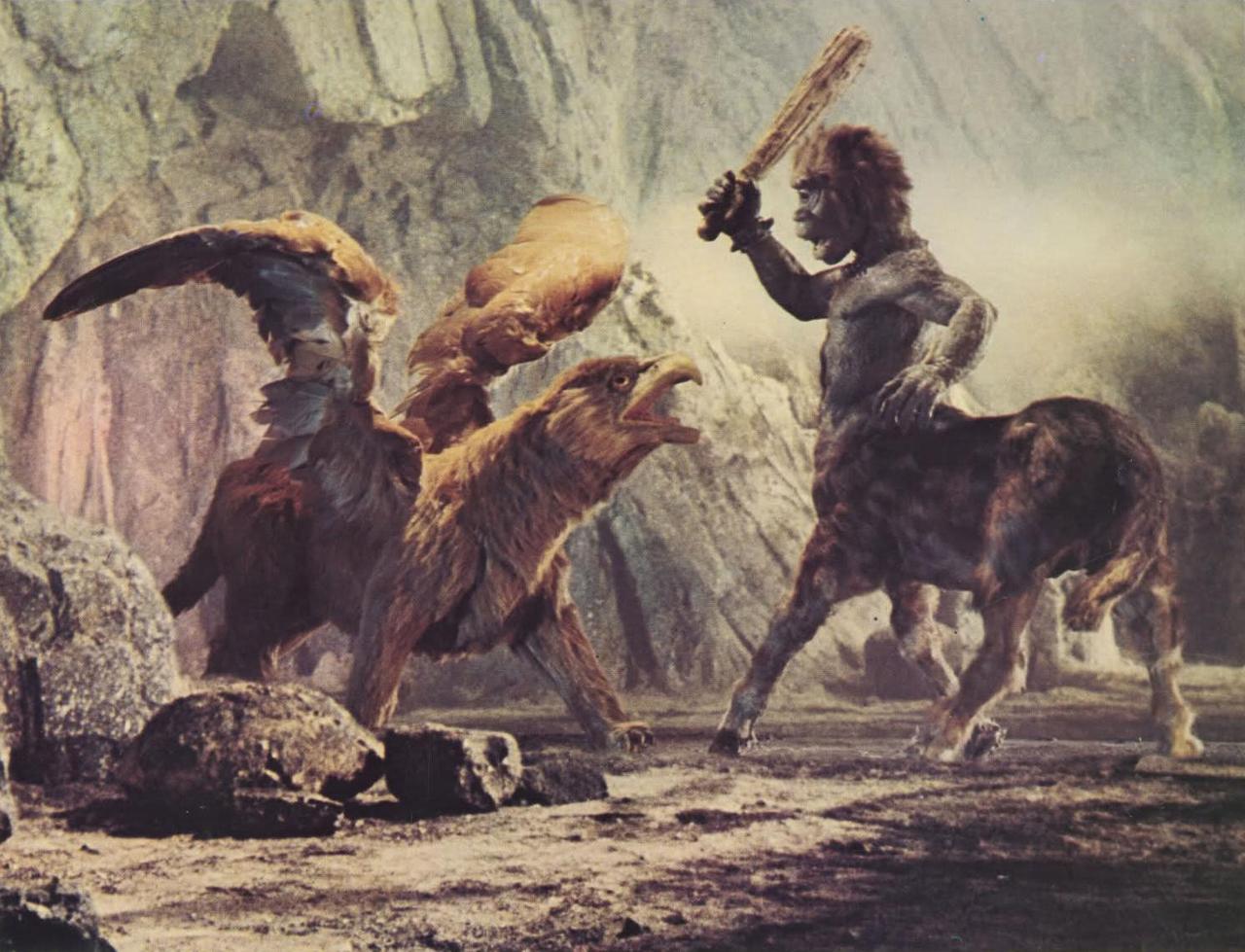
"Sinbad" defeats the evil "Prince Koura", wins the hand of "Margiana", a crown to rule a kingdom and riches beyond his dreams, BUT this is "Sinbad the Sailor". He takes the crown and places it on the head of the "Grand Vizier". The placing of the crown restores the "Vizier's" face to what it looked before his disfigurement and the Regent's clothing now turn to those of a "Sultan".
When "Marigana" asks "Sinbad" why he refused the crown he had won? His reply is:
I value freedom. A king is never really free. Why, he must even be told who he is to marry.Normally "Dell Comics" made a tie in for a motion picture, but in the case of "The Golden Voyage of Sinbad"/ The comic adaptation was from the MARVEL COMICS GROUP.


With both the success of the motion picture "The Golden Voyage of Sinbad" and the comic book in the United States and the United Kingdom. The Marvel Comics Group also made a comic version of "The Seventh Voyage of Sinbad" with the re-issue of the motion picture by Columbia Pictures.

In 1974 saw the Czechoslavkia made animated series of shorts ranging in length from 10 to 15 minutes. Each covered one of the Seven Voyages of "Sinbad the Sailor" and were released as "Pohadky tisice a jedne noci (Tales of 1,001 Nights)". A combined English dubbed version of 93 minutes was released under the title "The Adventures of Sinbad the Sailor".

On August 12, 1977 the final entry in the Ray Harryhausen and Charles H. Schneer "Sinbad" trilogy was released "Sinbad and the Eye of the Tiger". The cast is more interesting than the story as the picture contains elements from "The Golden Voyage of Sinbad".
In "7th Voyage of Sinbad" he marries the "Princess Parisa". In "The Golden Voyage of Sinbad" he married the slave girl "Margiana" and now he wants to marry the "Princess Farah". "Sinbad" does get a round with the ladies. Standing in his way is the female version of "Prince Koura". She is the evil step mother of "Prince Kassim" and the "Princes Farah". "Zenobia".
Here;s were that cast comes in.
"Sinbad" is portrayed by John Wayne's son Patrick. You'll find him in many of his dad's films such as "Rio Grande", "The Searchers", "The Conqueror", "The Alamo" and "McLintock". In 1988 Patrick Wayne portrayed "Pat Garrick" in "Young Guns", but not in 1990's "Young Guns II". When the role was played by William Petersen ten years before he became "Gill Grissom" on TV"s original "CSI".


Seen in the above still is Jane Seymour as "Princess Farah". Among her roles prior to this picture were the first Roger Moore "James Bond" film "Live and Let Die", an excellent remake of the British adventure "The Four Feathers" and the television mini-series "Captains and the Kings".
"Zenobia" was portrayed by British actress Margaret Whiting. Not to be confused with the American actress of the same name and spelling. Whiting is known mainly for her British television work, but for this role she was nominated for a "Saturn Award" for "Best Supporting Actress".
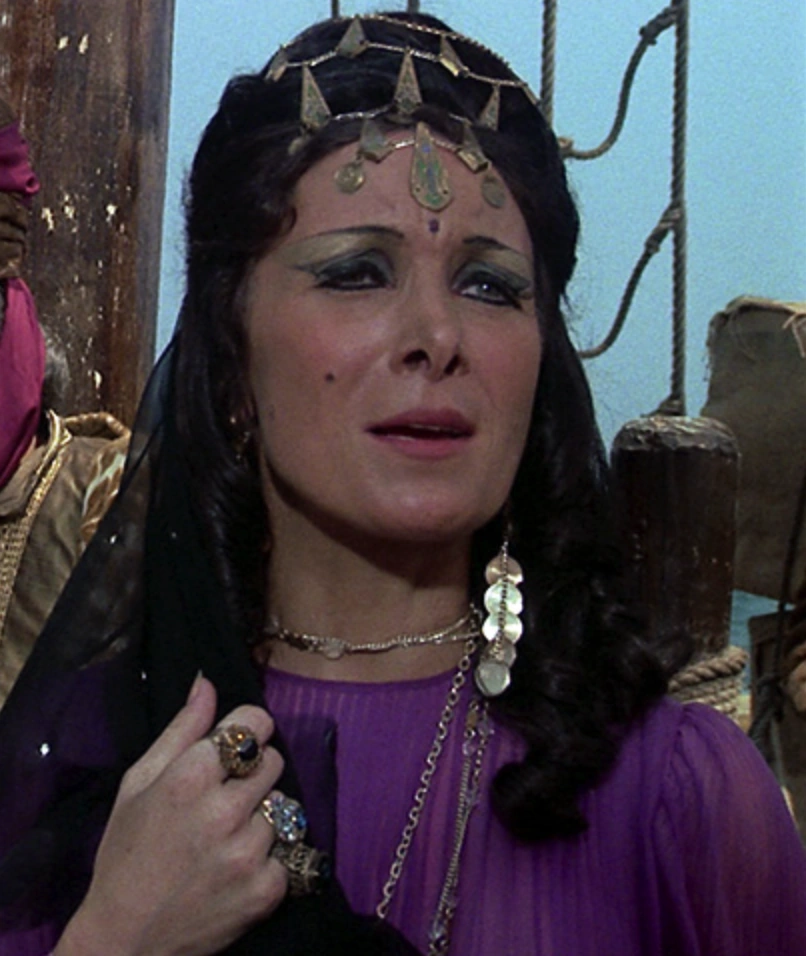
Portraying the old Greek Alchemist "Melanthius". Whom "Sinbad" and "Princess Farah" seek was Patrick Troughton. Troughton portrayed the "Second Doctor" on "Dr. Who". He was "Phineas" in Ray Harryhausen's "Jason and the Argonauts". Troughton was the "Rat Catcher" in "The Phantom of the Opera" and a "Body Snatcher" in "Frankenstein and the Monster from Hell".

Portraying the daughter of "Melanthius" "Dione" was Taryn Power. Taryn was the youngest daughter of actor Tyrone Power.

As I said in some respects we are seeing a remake of "The Golden Voyage of Sinbad". It is the coronation celebration for "Princess Farah's" brother "Kassim", Damien Thomas, but their evil step mother "Zenobia" casts a spell upon the prince. He is turned into a baboon.

"Sinbad", who is now the "Prince of Baghdad", arrives to ask "Kassim" for permission to marry "Farah". She tells him that her brother will stay a baboon forever, if in seven moons the curse is not lifted. "Zenobia's" son "Rafi", Kurt Christian, is next in line to be Caliph of the kingdom of Charak.
Instead of a group of "Homunculus" as in "The Golden Voyage of Sinbad". Ray Harryhausen, creates "Ghouls" that serve the same purpose and are created in a similar fashion. Which does affect "Zenobia" also.
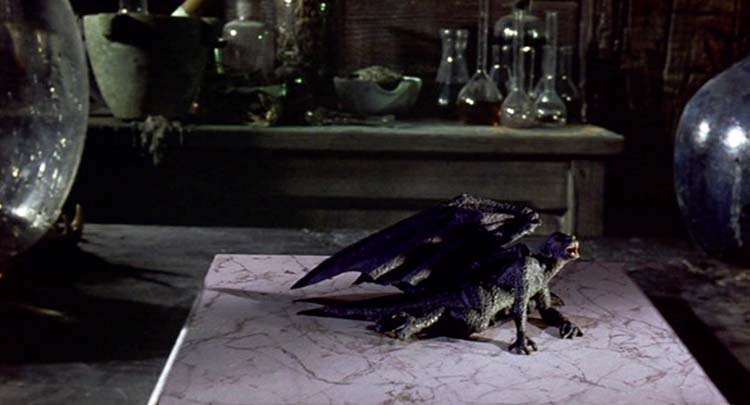
"Homunculus" above, "Ghouls" below.

"Sinbad" has heard of a Greek hermit named "Melanthius" who may help "Kassim". So "Sinbad', "Princess Farah","Kassim" as a baboon, and his crew set sail to find the hermit. Look at the still, above, of Jane Seymour playing Chess with the baboon. It is a marvelous sequence by Ray Harryhausen and to me the baboon is the finest animated work he has ever done. Also, think of the imagination Seymour had to have to pay chess with nothing in front of her.
"Zenobia" sets sail with her son "Rafi" to stop "Siubad" from finding "Melanthius". Instead of a ship with sailors. The difference on the two pictures has"Zeonbia" creating a "Mechanical Minotaur", she calls "Minaton", to row her ship.
"Sinbad" and "Princess Farah" find the hermit and his daughter "Dione". He agrees to help them, but they must find "Hyperborea", a land encased in ice, to find the cure for the spell. As the voyage continues 'Dione" becomes friends with "Kassim". This will lead to true love.
It should be noted by my reader that Robert E. Howard's fictional character "Conan the Barbarian" lived during the "Hyborian Age". The name was derived by Howard from the legendary northern land of the ancient Greeks called "Hyborea". As "Melanthius" is Greek the tie in makes sense.
At one point "Zenobia" transforms herself, by a potion, into a seagull to spy on "Sinbad's" ship. On her return she spills the potion and does not completely return to her previous form. Her left foot is still that of a seagull. I could not locate a photo of Margaret Whiting, but her image is on the above poster for the movie.
Before she turns back a wasp has landed upon the spilled portion, drinks and becomes larger. It attacks "Sinbad's" ship and kills three men.

"Sinbad" reaches "Hyborea" and goes ashore to search for the land called "Armaspi".His group are attacked by a giant Walrus, supplies are lost, and some men are killed. The Walrus may not be the best looking stop motion creature from Harryhsausen.
.

While this is occurring "Zenobia" and "Rafi" with "Minaton" enter a subterranean cave and find steps leading up to the tropical valley of "Armaspi". "Sinbad" and his remaining crew enter the Valley only to meet a "Troglodyte", but it turns out to be friendly and follows them around. Especially "Dione"!

"Zenobia" and "Rafi" are first to reach the pyramid they all seek, but has no key to enter. She orders the "Minaton" to remove a stone to permit their entry and after removing the stone. The pyramid becomes unstable and "Minaton" is crushed by falling rocks.
"Sinbad" and his group arrive at the pyramid and realize what has occurred. This will lead to the final confrontation with "Zenobia". "Rafi" is killed by the baboon "Kassim", but encased in a block of ice is a "Smiliodon" aka: "Sabre-tooth tiger". "Zenobia" brings it to life to kill "Sinbad" and those with him.

However, the "Troglodyte" appears and fights the tiger.
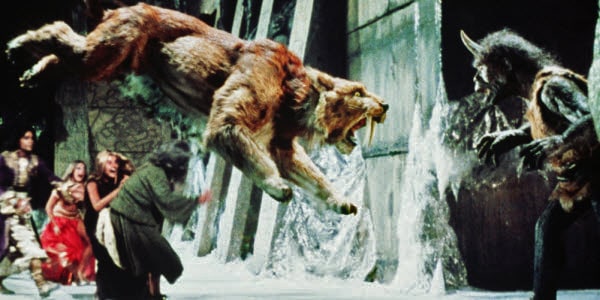
The "Troglodyte" is killed, but "Sinbad" picks up the spear used by their defender. With it he kills the tiger and it falls upon "Zenobia" crushing her to death.


The curse of "Kassim" is lifted. His bride to be is "Dione" and "Sinbad" is now free to marry "Princess Farah".
This was not the last "Sinbad" picture made, but as I previously stated. This ended the period of what were the best in live action and animated features. The following are examples of what followed "Sinbad and the Eye of the Tiger" to conclude my article.
Television's "The Incredible Hulk", Lou Ferrigno, starred in the Italian made "Sinbad of the Seven Seas". The movie on April 1, 1989 went straight to video.
The executive producers of the picture were Israeli executives Yoam Globis and Menehem Golan under their Cannon Film Group. The writers included Enzio G. Castellari, also the producer, and Tito Carpi. The four claim this picture is based upon Edgar Allan Poe's ""The Thousand-and-Second Tale of Scheherazade" However, if you read Poe's tale about "Sinbad's" 8th voyage. You will find no similarities, but have an interesting read.
Below Ferrigno and John Steiner as the evil "Jaffar".
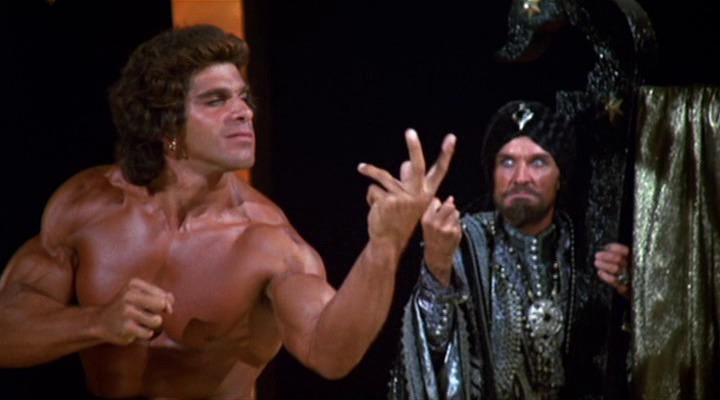
Steiner was a graduate of the Royal Academy of Dramatic Arts and appeared in the British comedy "Bedazzied" starring Dudley Moore and Peter Cooke in 1967 and that same year in "Marat/Sade" starring Patrick Magee, Ian Richardson and Glenda Jackson. Then John Steiner was invited to Italy to appear in an Italian Zapata Western entitled Tepepa" aka: Blood in Guns" in 1969 with third billing behind Orson Wells. He remained in Italy to make films. In "Sinbad of the Seven Seas" Steiner knew how to ham it up as the evil wizard "Jaffar" and steal the film.
The plot has "Sinbad" going on a quest to recover the magical stones to save the city of Basra.

"Sinbad of the Seven Seas" is so bad it's good.
February 18, 2000 saw "Sinbad Beyond the Veil of Mists" the first full length computer animated motion picture using motion capture. We've seen this story below. "Princess Serena" gets "Sinbad's
help to find the magic potion to save her father "King Akron" from the evil sorcerer "Baraka".

After all the hype the picture was shown on the big screen only in Los Angeles, Chicago and New York and went to video. The voice cast is interesting. "Sinbad" was voiced by Brendan Fraser, "King Akron" by John Rhys-Davies, "Baraka" by Leonard Nimoy, the "Captain of the Guard" by Mark Hamill and "Princess Serena" by voice actress Jennifer Hale.
On July 2, 2003 Dreamworks released the animated "Sinbad: Legend of the Seven Seas". The main voice actors were Brad Pitt as "Sinbad", Catherine Zeta-Jones as "Lady Marina" and Michelle Pfeffer as "Eris".
The film had a budget of $60 million dollars. It grossed only $80.7 million dollars causing a loss to Dreamworks of $125 million dollars. Which just missed bankrupting the company. "Sinbad the Sailor" was not a salable commodity anymore in the United States.
Which brings me to the 2010 and a made for television/video production by "The Asylum". Released on May 25th, "The 7 Adventures of Sinbad" aka: "The 7 Voyages of Sinbad", sounds too close to Ray Harryhausen's, 1958 classic, "The 7th Voyage of Sinbad", for a typical "Asylum Mockbuster" attempting to cash in on the May 28th release of Walt Disney's "Prince of Persia: The Sands of Time".
How this can be considered related to the Disney film, or "Sinbad" in general is stretching the audiences beliefs.
A 2010 multi-millionaire head of an oil company has his Indian Ocean rig sunk by Somalian pirates. He goes to investigate with several members of his company. Oh, I forgot to mention that his name is "Adrian Sinbad" and is a descendant of the original "Sinbad the Sailor".
The helicopter "Sinbad" and his employees are in becomes trapped in a storm and crashes in the Indian Ocean near an uncharted island. A stretch in these days of satellite mapping and searching. After swimming ashore "Adrian Sinbad" is attacked by a giant crab. Can you say Ray Harryhausen's, 1960, "The Mysterious Island"?

Above, "The 7 Voyages of Sinbad", below, "The Mysterious Island".

"Sinbad" finds his employees, the leader of the Somalian pirates and a beautiful female warrior living on the island. She tells him he has to stop "Elmec Ishu" a supernatural force. Fulling a long forgotten pledge of his family and become a warrior like her.
Instead of giant birds called "Roc's", in 1958's, "The 7th Voyage of Sinbad", the viewing audience has lying reptiles also called "Roc's".

Then there's a Cyclops and you can choose either Homer's "Odyssey", or Harryhausen's "7th Voyage of Sinbad" as it is blinded by "Sinbad" and killed.

As in that the warrior women's father is a leader of a group who wants to create a "Utopian Society", a hot air balloon escape and other elements of Jules Verne and you have this "Asylum" "Mockdrama:".
This is not to say "Sinbad" in Foreign Countries such as Japanese anime wasn't still popular, but in the United States he seems to have run his course. The last release, as of this writing, was also an anime from Japan shown in the English language dub on Netflix in 2016. The title was "Shindobaddo no Bōken), Sinbad no Bouken, or Magi - Sinbad no Bouken" in Japan and "Magi: Adventure of Sinbad" on television.


.jpg)


No comments:
Post a Comment